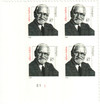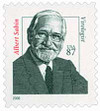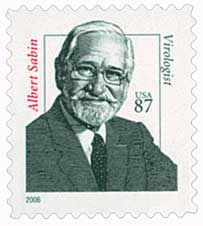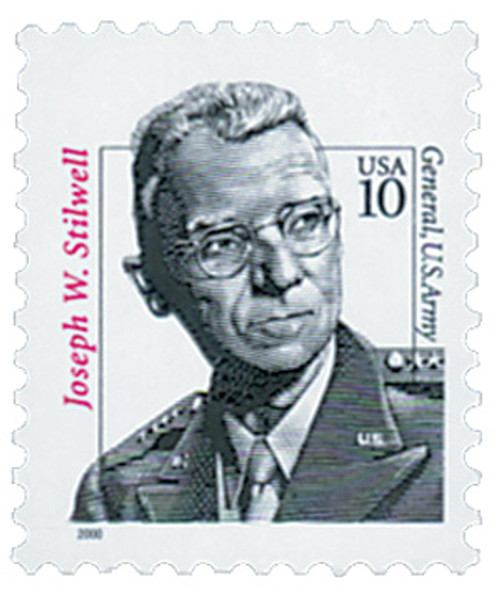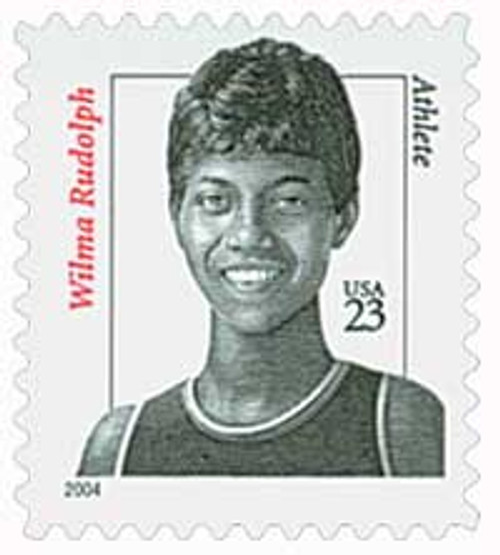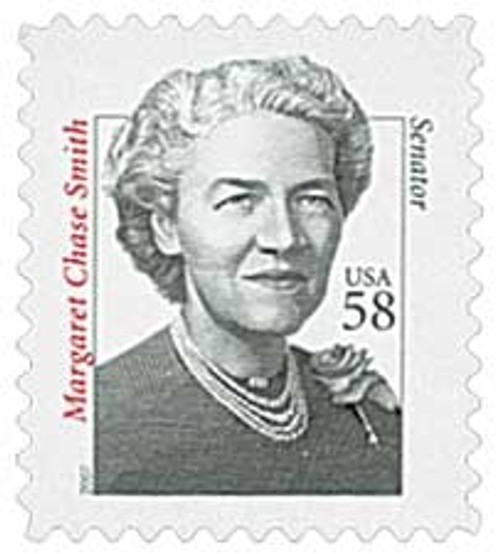
# 3435 - 2006 87c Distinguished Americans: Dr. Albert Sabin
87¢ Albert Sabin
Distinguished Americans Series
City: Washington, DC
Printing Method: Lithographed and engraved
Perforations: Serpentine Die Cut 11 ¼ x 11
Color: Red and black
Birth Of Albert Sabin
In 1921, Saperstein’s family moved to the United States and in 1930 he became a US citizen. At that time he also changed his name to Sabin and adopted the middle name, Bruce.
Sabin earned his medical degree from New York University in 1931 before training in internal medicine, pathology, and surgery at Bellevue Hospital. He then went to England in 1934 to research with the Lister Institute for Preventive Medicine. Sabin went on to join the Rockefeller Institute for Medical Research, where he became interested in the research of infectious diseases. And in1939 he moved to Cincinnati to work at the Children’s Hospital.
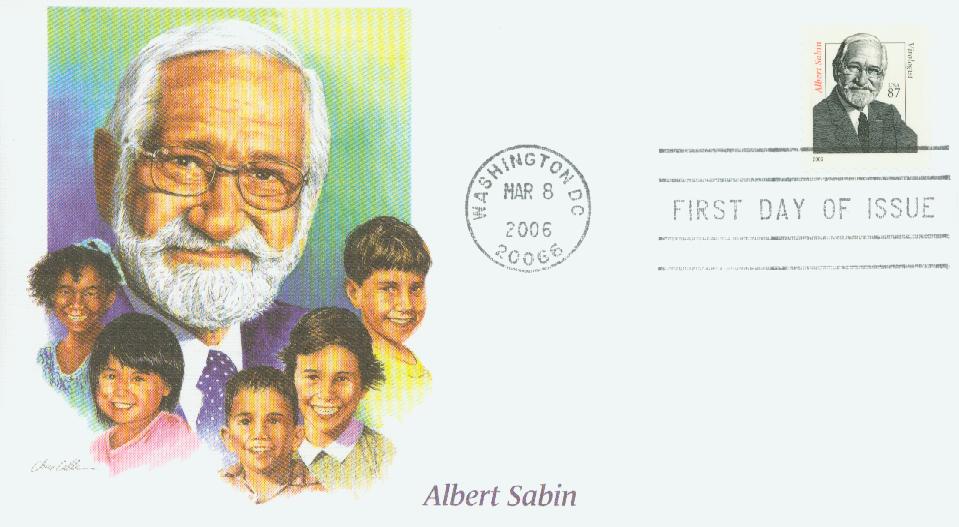
During World War II, Sabin joined the US Army Medical Corps. Reaching the rank of lieutenant colonel, he helped to create vaccines against dengue fever and Japanese encephalitis, diseases that plagued American soldiers. When the war was over, Sabin returned to his position at the Children’s Hospital and also became the head of Pediatric Research at the University of Cincinnati.
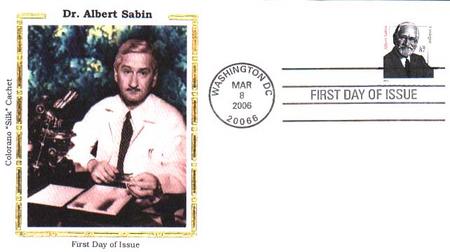
By the 1950s, polio became a worldwide epidemic. In a single year, 58,000 cases were reported, of which 3,145 people died and over 21,000 suffered paralysis. Several researchers began searching for a way to eradicate the dangerous disease. Among them were Sabin, Jonas Salk, and Hilary Koprowski. In 1955, Salk developed an injectable, killed-virus vaccine that was the first safe and effective vaccine against polio.
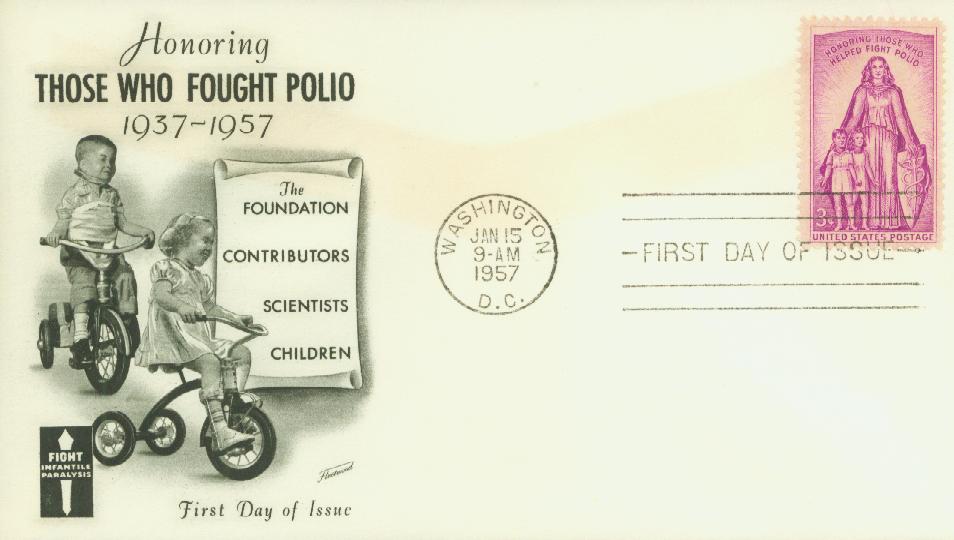
While Salk’s vaccine helped to prevent most of the complications associated with polio, it couldn’t prevent the initial infection. Around the same time, Sabin developed his own oral vaccine that contained weakened forms of the poliovirus. His vaccine was easier to administer and its effects lasted longer. He first tested the vaccine in 1954 and then spent several years working with Russian scientists to improve its effectiveness and safety.
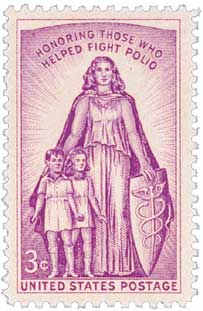
Between 1955 and 1961, Sabin tested his vaccine on 100 million people. It was then tested in Cincinnati and polio was eradicated from the city. In spite of the success, he did receive some opposition from the March of Dimes, which supported Salk’s vaccine. But Sabin’s vaccine was widely used around the world and is credited, along with Salk’s, with helping to nearly eradicate polio worldwide.
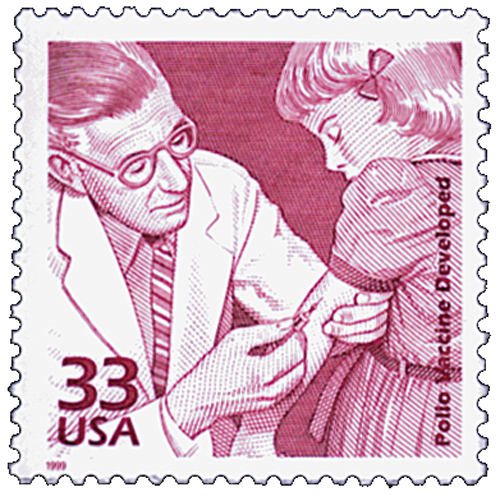
Sabin continued to work as a medical researcher for the rest of his life. He died on March 3, 1993, from heart failure. His achievements were recognized with the National Medal of Science and the Presidential Medal of Freedom. Sabin was also elected to the Polio Hall of Fame in Warm Springs, Georgia.
87¢ Albert Sabin
Distinguished Americans Series
City: Washington, DC
Printing Method: Lithographed and engraved
Perforations: Serpentine Die Cut 11 ¼ x 11
Color: Red and black
Birth Of Albert Sabin
In 1921, Saperstein’s family moved to the United States and in 1930 he became a US citizen. At that time he also changed his name to Sabin and adopted the middle name, Bruce.
Sabin earned his medical degree from New York University in 1931 before training in internal medicine, pathology, and surgery at Bellevue Hospital. He then went to England in 1934 to research with the Lister Institute for Preventive Medicine. Sabin went on to join the Rockefeller Institute for Medical Research, where he became interested in the research of infectious diseases. And in1939 he moved to Cincinnati to work at the Children’s Hospital.

During World War II, Sabin joined the US Army Medical Corps. Reaching the rank of lieutenant colonel, he helped to create vaccines against dengue fever and Japanese encephalitis, diseases that plagued American soldiers. When the war was over, Sabin returned to his position at the Children’s Hospital and also became the head of Pediatric Research at the University of Cincinnati.

By the 1950s, polio became a worldwide epidemic. In a single year, 58,000 cases were reported, of which 3,145 people died and over 21,000 suffered paralysis. Several researchers began searching for a way to eradicate the dangerous disease. Among them were Sabin, Jonas Salk, and Hilary Koprowski. In 1955, Salk developed an injectable, killed-virus vaccine that was the first safe and effective vaccine against polio.

While Salk’s vaccine helped to prevent most of the complications associated with polio, it couldn’t prevent the initial infection. Around the same time, Sabin developed his own oral vaccine that contained weakened forms of the poliovirus. His vaccine was easier to administer and its effects lasted longer. He first tested the vaccine in 1954 and then spent several years working with Russian scientists to improve its effectiveness and safety.

Between 1955 and 1961, Sabin tested his vaccine on 100 million people. It was then tested in Cincinnati and polio was eradicated from the city. In spite of the success, he did receive some opposition from the March of Dimes, which supported Salk’s vaccine. But Sabin’s vaccine was widely used around the world and is credited, along with Salk’s, with helping to nearly eradicate polio worldwide.

Sabin continued to work as a medical researcher for the rest of his life. He died on March 3, 1993, from heart failure. His achievements were recognized with the National Medal of Science and the Presidential Medal of Freedom. Sabin was also elected to the Polio Hall of Fame in Warm Springs, Georgia.





